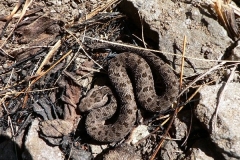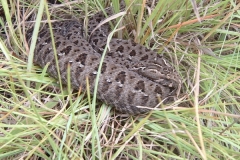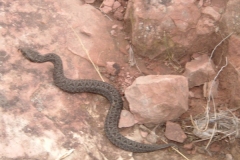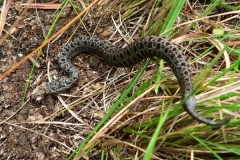Length:
40 – 50 cm average; 60 cm maximum
Description:
This is the most common poisonous snake in the Natal Drakensberg and is found on rocky mountain slopes at all altitudes, even the escarpment. It has a relatively narrower, longer head than the puff adder, is more lightly built, and has a much more patterned appearance, this consisting of two longitudinal light bands between which lie two wavy patterns joined at the middle. Below the longitudinal bands are some pale spots. The berg adders most commonly encountered are nowhere near the above lengths – 10 to 20 cm is a much more representative size. These younger snakes are dark grey to black, with light grey patterning. The rarer, larger adults may be dark brown with yellow / fawn patterning, and can become fat enough to be mistaken for a puff adder although the two species are very differently patterned.
The berg adder is responsible for the most bites amongst hikers and climbers, since it is in the habit of sunning itself on small rock ledges as well as paths. Many of the recorded bites have been to the hands and fingers, inflicted as hikers and climbers have attempted to clamber up steep slopes using ledges as hand-holds. It is a very irritable snake and is easily provoked into biting, although it prefers to escape from danger while making a loud hissing noise. Very small specimens hiss with such considerable vigour that their whole body vibrates, and it sounds like they are squeaking.
Biology:
The diet consists mainly of small rodents and the nestlings of ground-living birds, but also includes lizards and snakes. On average 8 to 15 live young are produced at a time.
Poisoning Symptoms:
The venom is neurotoxic (nerve-destroying), which is unusual for the adder species of southern Africa. It causes paralysis of cranial nerves III, IV and VI. The bite area and affected limb will show some swelling. Within an hour of being bitten vision will be impaired and the eyelids will droop. These early symptoms can cause confusion with the bite of a rinkhals, except that breathing difficulties never occur. The senses of taste and smell are usually lost. After 24 hours paralysis of the eye, tongue and mouth muscles occurs and usually persists for 3 to 4 days. Normal vision is usually recovered by the sixth day, but visual abnormality may persist until the fifteenth day.
There are only two known cases of berg adder bites proving fatal (*citation needed), and as far as is known both victims were bitten intravenously – i.e. the venom was injected directly into a blood vessel. However, it is possible that other factors such as age and health could also have played a part.
Treatment:
Treat as an emergency. Calm and immobilise the victim. Use a suction kit if you have one (the Aspivenin kit is highly recommended). APPLY A PRESSURE BANDAGE. Contact a Poison Information Centre and hospitalise the victim as soon as possible. Because of paralysis of the tongue the victim will experience difficulty swallowing and excess saliva will have to be removed artificially. Antivenin has no effect against the venom of this species.
Remarks:
Although the symptoms of a berg adder bite can be alarming, they are nowhere near as serious as those of the puff adder or rinkhals. Berg adder bites are seldom fatal, although young or physically weak victims can succumb to complications. The main concern is to get the victim to a hospital before complete paralysis of the tongue sets in.




